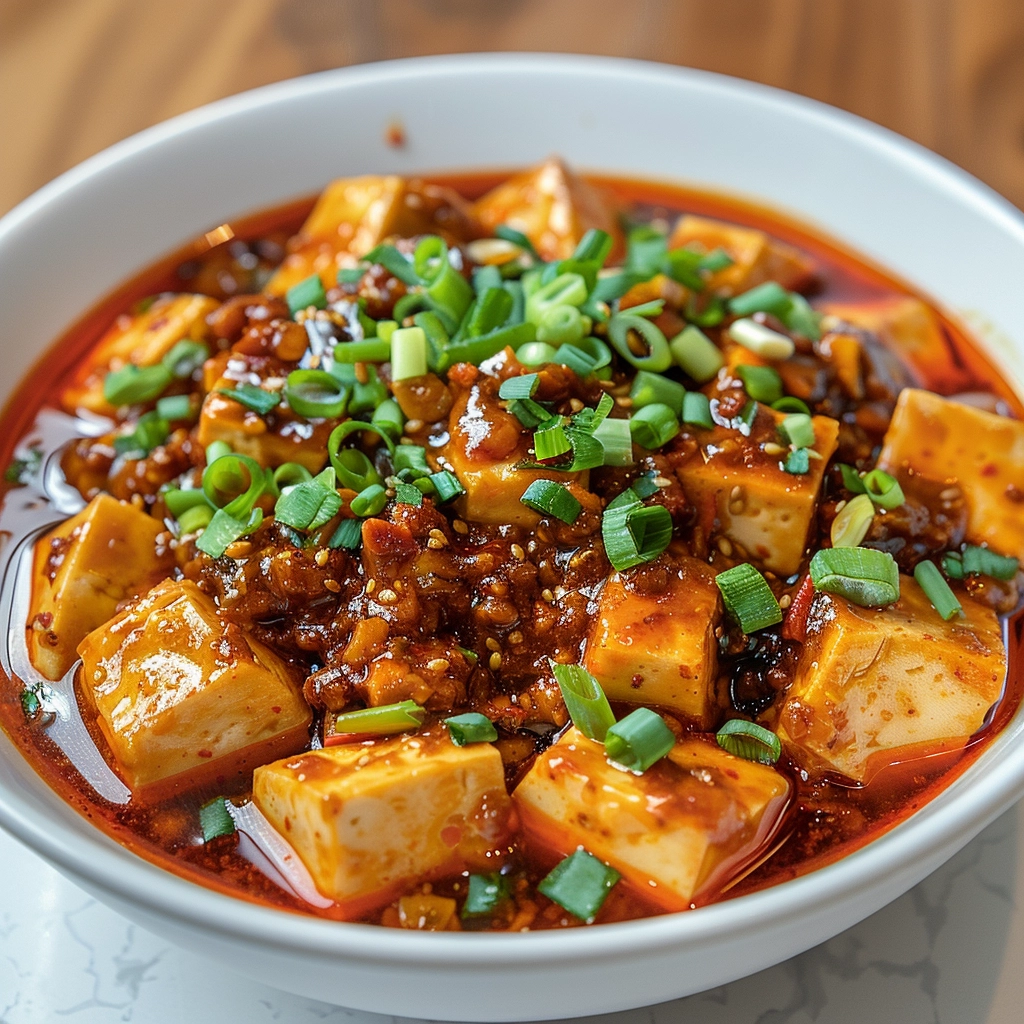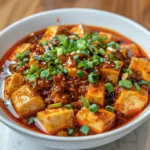If you’re a fan of big, bold flavors and crave that irresistible mix of spicy, savory, and mouth-tingling goodness, Mapo Tofu is your new weeknight hero. This iconic dish from Sichuan combines soft tofu with a rich, chili-bean sauce, tender morsels of ground pork (or beef), and that famous numbing kick from Sichuan peppercorn. It’s saucy comfort with a fiery soul—one bite and you’ll understand why Mapo Tofu is beloved around the world.
Ingredients You’ll Need
The beauty of Mapo Tofu lies in its straightforward yet authentic ingredients. Each element not only enhances the dish’s signature flavors but also helps create its irresistible texture and vibrant color. Here’s what you’ll need and how they make this classic sing:
- Soft tofu: The gentle, pillowy texture of soft tofu soaks up all the spices and sauces beautifully; make sure to cut it into even cubes for the best mouthfeel.
- Ground pork or beef: Adds richness and a satisfying, meaty contrast to the delicate tofu.
- Sichuan chili bean paste (doubanjiang): This fermented paste is the heart of Mapo Tofu, delivering bold umami and signature fiery color.
- Fermented black beans (optional): Crumbled and rinsed, these beans deepen the flavors with a savory, slightly funky punch—use them if you want to go truly authentic.
- Garlic: Freshly minced, it loads the dish with pungent and aromatic layers.
- Ginger: Another aromatic powerhouse, ginger rounds out the spice and brightness.
- Scallions: Both the white and green parts are used for two different pops of flavor and color.
- Soy sauce: Enhances umami and adds that vital salty depth.
- Sugar: Just a touch, it balances the heat and rounds out the savory flavors.
- Sichuan peppercorns: Toasted and ground, these give Mapo Tofu its addictive, tongue-tingling sensation.
- Chicken broth or water: The liquid base for the sauce; chicken broth adds extra richness, but water works for a lighter touch.
- Cornstarch mixed with water: Thickens the sauce so it clings luxuriously to each tofu cube.
- Vegetable oil: For sautéing and infusing the aromatics.
- Chili oil: Drizzled at the end for a glossy, spicy finish that brings everything together.
How to Make Mapo Tofu
Step 1: Toast the Sichuan Peppercorns
Begin by heating vegetable oil in your wok or skillet over medium heat. Add those magical Sichuan peppercorns and toast them just briefly to unlock their characteristic aroma and numbing flavor. As soon as they start to release their fragrance, scoop them out so they don’t turn bitter. This step is essential for that telltale tingle in Mapo Tofu.
Step 2: Sauté the Aromatics
In the same sizzling oil, toss in the minced garlic, ginger, and the white segments of your scallions. Quickly sauté until everything becomes fragrant—this only takes a few moments, but the transformation in aroma hints at the flavor-packed journey you’re about to embark on.
Step 3: Brown the Meat
Stir in your ground pork or beef, breaking it apart with a spatula. Cook until browned and crumbly; the meat should absorb those garlicky and gingery notes, contributing a savory backbone to the dish.
Step 4: Build the Flavor Base
Time to introduce Sichuan chili bean paste and fermented black beans. As you stir-fry, you’ll notice the oil turning a gorgeous red hue. Make sure the bean paste fully combines with the meat and aromatics, as this is where the deep umami of Mapo Tofu is born.
Step 5: Simmer with Broth and Seasonings
Pour in the soy sauce, sugar, and your choice of chicken broth or water. Bring everything to a gentle simmer—this helps all those robust flavors meld beautifully, and gives your sauce a deliciously savory depth.
Step 6: Add the Tofu
Carefully slide in your tofu cubes. To keep them intact, stir gently or simply spoon the sauce over them as they simmer. Let this bubble away for 5 to 7 minutes so the tofu absorbs every drop of flavor.
Step 7: Thicken and Finish
Stir in the cornstarch slurry and watch as your sauce instantly transforms from soupy to thick and silky—perfect for clinging to rice. Finish by drizzling in chili oil and a shower of green scallions. Your Mapo Tofu masterpiece is ready to take center stage.
How to Serve Mapo Tofu
Garnishes
A final flourish will make your Mapo Tofu look (and taste) even more inviting. Scatter on extra scallion greens and a last sprinkle of toasted Sichuan peppercorns for visual appeal and bold, aromatic pops. A drizzle of chili oil adds an extra layer of spice and that restaurant-style sheen.
Side Dishes
Mapo Tofu makes a show-stopping main, but it plays well with all sorts of sidekicks. Steamed jasmine rice is the classic pairing, soaking up the saucy goodness. For a lighter touch, try it alongside garlicky stir-fried greens, or some simple cucumber salad to cool the heat. This dish is all about balance!
Creative Ways to Present
If you’re looking to wow your dinner guests, serve Mapo Tofu family-style in a big, shallow bowl, letting everyone help themselves. For a fun twist, spoon the tofu over freshly cooked noodles or pile it on top of crispy rice cakes. However you serve it, expect plenty of requests for seconds.
Make Ahead and Storage
Storing Leftovers
If you find yourself with leftover Mapo Tofu, let it cool to room temperature, then transfer to an airtight container in the fridge. It keeps well for about 2 to 3 days, and the flavors get even deeper overnight, making a delicious lunch or speedy dinner the next day.
Freezing
While tofu dishes can sometimes be tricky to freeze, Mapo Tofu does surprisingly well! Place fully cooled portions in freezer-safe containers. Just keep in mind that the tofu may get a touch spongier after thawing, but the flavors remain delicious. Enjoy within 1 month for best results.
Reheating
Gently reheat Mapo Tofu in a saucepan over medium-low heat, adding a splash of water or broth if the sauce seems thicker than you like. If you’re in a hurry, the microwave works too; just stir halfway through so everything heats evenly.
FAQs
Can I make Mapo Tofu vegetarian or vegan?
Absolutely! Swap the meat for finely diced mushrooms or plant-based ground crumbles. Use vegetable broth instead of chicken, and check your doubanjiang to ensure it’s free from animal products. The flavors are just as bold and satisfying!
Is Mapo Tofu supposed to be super spicy?
The beauty of Mapo Tofu is that you can adjust the spice level to suit your taste. Start with less chili bean paste or chili oil if you’re sensitive to heat, and build up from there. The authentic Sichuan version is famously spicy, but home cooking means making it just right for you.
What can I use if I can’t find Sichuan peppercorns?
If genuine Sichuan peppercorns aren’t available, you can use a mix of white pepper and a hint of black pepper for some pungency, though you won’t get that signature tingling sensation. Order online if you can—the unique flavor is worth seeking out for Mapo Tofu!
Can I use firm tofu instead of soft?
Firm tofu works in a pinch and is easier to handle, but soft or silken tofu creates the classic, “pillowy soft” texture that makes Mapo Tofu so delightful. With gentle stirring, soft tofu holds together better than you might expect.
How do I make the sauce extra glossy and thick?
The cornstarch slurry is key! Make sure to mix cornstarch with cold water before adding to the simmering sauce, then stir gently as it thickens. If you want it even silkier, add a touch more slurry. The sauce should cling to each bite without being gummy.
Final Thoughts
Mapo Tofu brings every meal to life with its punchy flavors, comforting texture, and the kind of warmth that sticks with you. Whether you’re brand new to Sichuan cooking or a lifelong fan, I wholeheartedly encourage you to try making Mapo Tofu at home. You might just end up with a new favorite dish to share and savor!
PrintLavender Meringue Honey Cupcake Recipe
Mapo Tofu is a fiery and comforting Sichuan specialty featuring silky tofu cubes, richly seasoned with ground pork (or beef), fermented chili-bean paste, and tingling Sichuan peppercorns. The result is a dynamic balance of numbing spice, umami depth, and crave-worthy texture, topped with fresh scallions for a vibrant finish—a perfect weeknight main that delivers authentic flavor in under 30 minutes.
- Prep Time: 10 minutes
- Cook Time: 15 minutes
- Total Time: 25 minutes
- Yield: 3 servings 1x
- Category: Main-course
- Method: Stovetop
- Cuisine: Chinese (Sichuan)
- Diet: Low Lactose
Ingredients
Tofu and Protein
- 14 oz soft tofu, cut into cubes
- 1/2 lb ground pork or beef
Sauces and Seasonings
- 2 tbsp Sichuan chili bean paste (doubanjiang)
- 1 tbsp fermented black beans (optional), rinsed and chopped
- 1 tbsp soy sauce
- 1/2 tsp sugar
- 1 tsp Sichuan peppercorns, toasted and ground
- 2 tbsp vegetable oil
- Chili oil, to taste (for finishing)
Aromatics
- 3 cloves garlic, minced
- 1-inch piece ginger, minced
- 2 scallions, chopped (white and green parts separated)
Liquids and Slurry
- 1 cup chicken broth or water
- 1 tbsp cornstarch mixed with 2 tbsp water
Instructions
- Toast the Peppercorns: Heat the vegetable oil in a wok or large skillet over medium heat. Add the Sichuan peppercorns and toast briefly until fragrant. Use a slotted spoon to remove the peppercorns, leaving the oil infused with their flavor.
- Sauté Aromatics: Add minced garlic, ginger, and the white parts of the chopped scallions to the hot oil. Sauté for about 1 minute until very fragrant.
- Brown the Meat: Stir in the ground pork or beef. Cook, breaking it up, until fully browned and no longer pink.
- Add Chili Bean Paste and Black Beans: Mix in the Sichuan chili bean paste and fermented black beans. Stir-fry for 1–2 minutes, allowing the oil to turn a deep red and the paste to become very aromatic.
- Create the Sauce: Pour in the soy sauce, sugar, and chicken broth (or water). Stir well, scraping up any browned bits from the pan, and bring to a gentle simmer.
- Simmer the Tofu: Gently add the tofu cubes, taking care not to break them. Simmer for 5–7 minutes, so the tofu absorbs the flavorful sauce.
- Thicken the Sauce: Stir the cornstarch slurry to recombine, then pour it into the simmering tofu. Cook, gently stirring, until the sauce thickens and coats each tofu cube.
- Finish and Serve: Drizzle chili oil to taste and sprinkle with the green parts of the scallions. Serve hot, ideally over steamed rice.
Notes
- For a vegetarian version, omit the meat and add more mushrooms or plant-based protein.
- Adjust chili oil and peppercorns to your preferred spice level.
- If you can’t find doubanjiang, substitute with miso and chili paste, though the authentic flavor may vary.
- Soft or silken tofu gives a delicate texture, but medium tofu is easier to handle if you prefer firmer pieces.
- Serve immediately for the best texture and flavor.
Nutrition
- Serving Size: 1/3 of recipe
- Calories: 330 kcal
- Sugar: 3g
- Sodium: 900mg
- Fat: 20g
- Saturated Fat: 4g
- Unsaturated Fat: 14g
- Trans Fat: 0g
- Carbohydrates: 13g
- Fiber: 2g
- Protein: 21g
- Cholesterol: 45mg


